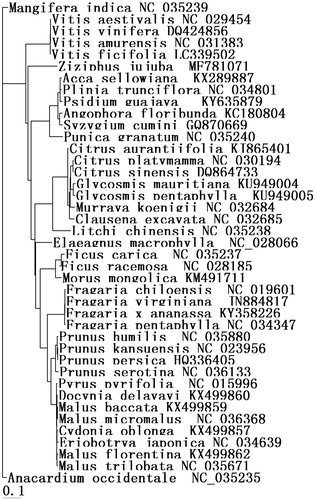Abstract
The common mango is known as ‘king of fruits’ and the second most important tropical fruit crop. Mango production plays an important role in the rural economy of many tropical and subtropical countries. In this study, we sequenced its circular complete chloroplast genome (cpDNA) of mango. The complete cpDNA was 157,837 bp in length and consisted of a pair of inverted repeats (IRs) of 40,428 bp, a large single copy (LSC) region of 59,717 bp, and a small single copy (SSC) region of 43,323 bp. Totally, 171 genes were predicted, including 118 protein-coding genes, 8 ribosomal RNA genes, and 45 tRNA genes. Phylogenetic analysis of all sequenced chloroplast genomes in the fruit suggested that mango was closely related to three other Citrus species. The results indicate that the chloroplast genomes are good resources for developing new DNA markers for taxonomy and also as tools for evolutionary research of closely related species in future studies.
Keywords:
Mango is an evergreen tree belonging to the family of Anacardiaceae. There are 41 species of Mangifera L. recognized in the world, of which about 15 species of fruit can be eaten. Mangifera.indica L. is widely cultivated in all parts of the world. In China, there are three species of which Mangifera sylvatica Roxb.L in Yunnan, Mangifera persiciformis C. Y. Wu in Guangxi, and Mangifera longipes in Hainan Island. According to the ecological characteristics and distribution areas of these varieties, some scholars had classified mango varieties into four species group (variety type): Philippines species group, India tiger branch group, India variety group, and Western India variety group, also divided them into three species groups: Indochina variety group, Indonesian cultivar group, and India cultivar group (Kostermans and Bompard Citation1993). Chloroplast genome sequences are of great phylogenetic, conservation genetics, and population genetic value due to their relatively conserved structure and comparatively high-substitution rates (Ravi et al. Citation2008). In this study, we determined the complete chloroplast genome sequence of mango, hence adding a new reported chloroplast genome to the Mangifera indica var GuiFei. Fresh leaves of mango were collected from mango germplasm resource nursery of Ministry of Agriculture, N20°02′45.97″ E110°11′38.39″ in Danzhou, Hainan province, China. Total DNA was extracted using the DNeasy Plant Mini Kit (50)(QIAGEN, China (Shanghai) Co., Ltd.) and at −20-degree freezer in the laboratory and sequenced on the Illumina Hiseq 2000 Platform. With the data obtained, we then filtered and assembled the complete chloroplast genome using CLC genomics workbench as previously reported (Nock et al. Citation2011). The complete chloroplast genome was annotated with Dual Organellar GenoMe Annotator (Wyman et al. Citation2004). A physical map of the chloroplast genome was generated with OGDRAW (Lohse et al. Citation2013). To confirm the phylogenetic position of mango, this newly determined chloroplast genome was aligned with 41 reported chloroplast genome sequences from NCBI (http://www.ncbi.nlm.nih.gov) of the main fruit trees plants with BioEdit 7.2 software (Tom hall). We analyzed 10000 nucleotide sequences from each species by a neighbor phylogenetic tree. The complete chloroplast genome of mango was a double-stranded circular DNA of 157,837 bp in length. Its quadripartite structure was composed of two inverted repeated regions (IRa and IRb) of 40,428 bp, separated by a large single-copy (SSC) region of 43,323 bp, and a small single-copy (LSC) region of 59,717 bp. The genome organization, gene content and the relative positions of its 171 individual genes (118 protein-encoding genes, 45 tRNA genes, and 8 rRNA genes) were almost different to those of the other fruit tree chloroplast genomes. Thirty-three genes had two or more copies, eighteen genes were duplicated in the IR regions, twenty-two gene in the SSC regions. Phylogenetic analysis of 41 chloroplast genomes from the different fruit tree plants showed that mango was closely related to three other Citrus species (). The complete chloroplast genome of Mangifera indica that we present in this study will provide valuable information to develop highly variable DNA markers for mango population and hybridization studies in the future.
Disclosure statement
No potential conflict of interest was reported by the authors.
Additional information
Funding
References
- Kostermans A, Bompard JM. 1993. The mangos: their botany, nomenclature, horticulture and utilization. Cambridge, Massachusetts. Academic Press.
- Lohse M, Drechsel O, Kahlau S, Bock R. 2013. Organellar Genome DRAW-a suite of tools for generating physical maps of plastid and mitochondrial genomes and visualizing expression data sets. Nucleic Acids Res. 41:575–581.
- Nock CJ, Waters DL, Edwards MA, Bowen SG, Rice N, Cordeiro GM, Henry RJ. 2011. Chloroplast genome sequences from total DNA for plant identification. Plant Biotechnol. J9:328–333.
- Ravi V, Khurana JP, Tyagi AK, Khurana P. 2008. An update on chloroplast genomes. Plant Syst Evol. 271:101–122.
- Wyman SK, Jansen RK, Boore JL. 2004. Automatic annotation of organellar genomes with Dogma. Bioinformatics. 20:3252–3255.

